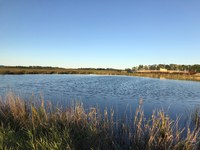Pump Containment Ponds Before Unpermitted Release Occurs
(Click the image below to view a high-resolution image that can be downloaded)
The recent rainfall and upcoming forecast are proving to be a challenge, not only for harvesting crops but also for livestock producers.
“If you are a livestock producer with a manure management system, you need to inspect your dirty-water containment ponds,” advises Mary Keena, Extension livestock environmental management specialist based at North Dakota State University’s Carrington Research Extension Center.
Keena says producers must maintain 2 feet of freeboard to accommodate a 24-hour, 25-year storm event in their ponds. If a pond is level with or measuring in the freeboard area, producers must pump the pond.
“After obtaining a sample of the containment pond water and sending it to a laboratory for nutrient analysis, you can pump onto cropland or hay land,” Keena says. “The nutrient content of the containment water is minimal, but it is still important to have it sampled and record the number of gallons applied so your nutrient management plan can be updated to include the pumping.”
Keena suggests producers follow an example of how to determine the amount of effluent to apply in the “Containment Pond Management” publication at https://www.ag.ndsu.edu/lem/resources/useful-publications.
“Allowing your containment ponds to overtop is not only a violation of your animal feeding operations permit, it is also cost prohibitive,” says Rachel Strommen, environmental scientist at the North Dakota Department of Environmental Quality. “The water leaving the containment pond via a breach may cause erosion that will be costly to fix. Also, when the water leaves on its own accord, it cannot be directed to a safe source (cropland) and can be the source of unnecessary pollution to waters of the state.”
Water that leaves the containment pond and enters waters of the state via a culvert, ditch, creek or other waterway is considered an unpermitted release, Strommen noted.
If your containment pond does have an unpermitted release, you must call the North Dakota Department of Environmental Quality (NDDEQ) at 701-328-5210 to report the incident. You will be required to keep records of all weather events that caused the release, date of release, time of release, location of release, volume of manure or runoff released, and the actions taken to clean up and minimize the release.
If you have questions about your containment pond, contact your local NDSU Extension agent (https://www.ag.ndsu.edu/extension/directory) or the NDDEQ Division of Water Quality at 701-328-5210 or https://deq.nd.gov/WQ.
NDSU Agriculture Communication - Sept. 25, 2019
| Source: | Mary Keena, 701-652-2951, mary.keena@ndsu.edu |
|---|---|
| Source: | Rachel Strommen, 701-328-5210, rstrommen@nd.gov |
| Editor: | Becky Koch, 701-231-7875, becky.koch@ndsu.edu |


